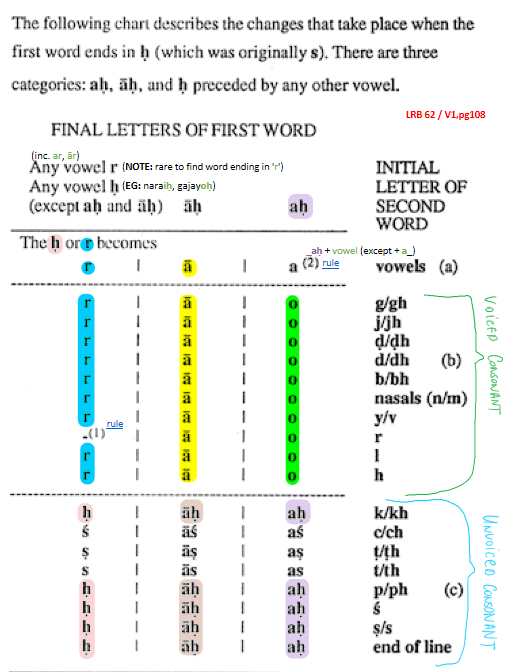Lesson 14: Sanskrit for Beginners Course: Genitive + Ablative Cases
Summary:
Two new cases: Genitive, Ablative, Sandhi.
Source: Introduction to Sanskrit (4th Ed) – Thomas Egenes – Part One
Resources:
Highlights:
-
CASE: Ablative
- Summary:
- from __
- Formula:
- stem + at
- Paradigm:
- Summary:
| nara + at narāt From the man |
nara + abhyām narābhyām From two men |
nara + ebhyaḥ narebhyaḥ From many men |
-
- Examples:
| aśvaḥ narāt gacchati (अश्वो नरात् गच्छति) | Horse goes from the man. |
| gajāt āgacchati (गजात् आगच्छति) | He comes from the elephant. |
| putraḥ aśvebhyaḥ āgacchati | The son comes from the horses. |
| gajāḥ narābhyām āgacchanti | The elephants come from the two men. (How do we know it's not dative, “for the two men”? We don't know directly. However context will tell indirectly). |
| caṣakāt jalam pibāmi | I drink water from the cup. |
| rāmaḥ grāmāt āgacchati | Rāma comes from the village. |
-
CASE: Genitive
- Used when?
- To express possession / to have
- Summary:
- of __ / __‘s : of the man / man's
- Formula:
- stem + sya
- Paradigm:
- Used when?
| nara + sya narasya Of the man |
nara + yoḥ narayoḥ Of two men |
nara + anām narāṇām Of many men |
-
- Rule:
- Always goes before the noun it's associated with: GEN NOUN
- EG: Boy's horse : bālasya aśvaḥ
- Always goes before the noun it's associated with: GEN NOUN
- Examples:
- Rule:
| narasya aśvaḥ | Horse of the man. / Man's horse. |
| (bālasya aśvaḥ) rāmam gacchati | (Boy's horse) goes to Rāma. / (Horse of the boy) goes to Rāma. |
| (narāṇām nṛpam) vīraḥ smarati | The hero remembers (the king of men). |
| (amṛtasya vīrāḥ) putrāya rāmam gacchanti | (Heroes of immortality) go to Rāma, for the son. |
| nṛpaḥ (vīrasya aśvam) paśyati | The king sees the (horse of the hero). |
-
- To have:
- There is NO “to have” verb in Sanskrit. Ideally “Man has a son” would be “rāmaḥ putram HAS“.
- Then how do we say “Man has a son“?
- Of the man, a son is. > narasya putraḥ bhavati
- Examples:
- Rāma has horses. > Of Rāma, horses are. > rāmasya aśvāḥ bhavanti
- I have a son. > Of me, son is. > mama putraḥ bhavati/asti
- To have:
-
Sandhi:

-
- Examples of usage:
| any_vowelḥ (except ā/a) | āḥ | aḥ |
| naraiḥ bhavanti > narairbhavanti (नरैर्भवन्ति) | narāḥ bhavanti > narā bhavanti (नरा भवन्ति) | naraḥ bhavati > naro bhavati (नरो भवति) |
| vīraiḥ kutra > vīraiḥ kutra (वीरः कुत्र) | vīrāḥ kutra bhavanti > vīrāḥ kutra bhavanti (वीरा कुत्र भवन्ति) | vīraḥ kutra asti > vīraḥ kutrāsti (वीरः कुत्रास्ति) |
| nṛpaiḥ ca > nṛpaiśca (नृपैश्च) | nṛpāḥ ca > nṛpāśca (नृपाश्च) | nṛpaḥ ca > nṛpaśca (नृपश्च) |
| putraiḥ tiṣṭhanti > putraistiṣṭhanti (पुत्रैस्तिष्ठन्ति) | putrāḥ tiṣṭhanti > putrāstiṣṭhanti (पुत्रास्तिष्ठन्ति) | putraḥ tiṣṭhati >putrastiṣṭhati (पुत्रस्तिष्ठति) |
| narayoḥ mṛgaḥ > narayormṛgaḥ | ||
| guruḥ gacchati > gururgacchati |
Homework:
- Learn vocab on Spoken Sanskrit 7.
- Learn new vocab on pg 60 of book (just 2 new words: āgacchati, grāmaḥ)
- Complete following exercises on pg 61:
- 3
- 4 a, b, d, f
- 5 b, i
- 6 a, d, e, f, h, i, j
Questions:
You'll have more questions throughout the course. How to ask? Leave in comments below, so others can also benefit. We'll respond within 48 hours. Only ask specific to this Lesson.
—
Recorded 25 Oct, 2020


Hi Andre,
Thanks for the lessons. I have been following them offline. After multiple failed attempts trying to learn Sanskrit, I feel much more confident now after following your lessons.
I have a question about visarga sandhi. In the āḥ example, why does vīrāḥ kutra bhavanti become vīrā kutra bhavanti ? Per the table, it should not undergo any change.
Corrected my mistake. Sharp eye Shobana. Indeed, no sandhi change. Have we considered joining the webinar? The advantage of the course is the 40min of interacting with others.
Sharp eye Shobana. Indeed, no sandhi change. Have we considered joining the webinar? The advantage of the course is the 40min of interacting with others.
I would love to join the course. I did register my interest to join. I am currently missing out on the class conversations and exercises. Is there a way you can publish the answers to the exercises so I can do it on my own and verify?
If been following the videos, gladly welcome to join class. Will give link via email.
How to translate to english for this case:
Yosit vairasya kaaranam
How to know the difference between genitive objective and genitive subjective
Where does it mention in the course genitive objective and genitive subjective? There’s only genitive, which is “vairasya”.
Also, please write in IAST form by lesson 14. EG: kāraṇam, and not “kaaranam”.